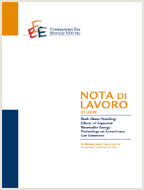Bridging the Gap: Do Fast Reacting Fossil Technologies Facilitate Renewable Energy Diffusion?

19.07.2016
Elena Verdolini (Fondazione Eni Enrico Mattei, Centro Euro-Mediterraneo per i Cambiamenti Climatici); Francesco Vona (OFCE Sciences-Po, SKEMA Business School); David Popp (Syracuse University, NBER)
Q42, Q48, Q55, O33
Renewable Energy Investments, Fossil Energy Investments, Complementarity, Energy and Environmental Policy
Mitigation, Innovation and Transformation Pathways
Massimo Tavoni
Energy Policy
The diffusion of renewable energy in the power system implies high supply variability. Lacking economically viable storage options, renewable energy integration has so far been possible thanks to the presence of fast-reacting mid-merit fossil-based technologies, which act as back-up capacity. This paper discusses the role of fossil-based power generation technologies in supporting renewable energy investments. We study the deployment of these two technologies conditional on all other drivers in 26 OECD countries between 1990 and 2013. We show that a 1% percent increase in the share of fast-reacting fossil generation capacity is associated with a 0.88% percent increase in renewable in the long run. These results are robust to various modifications in our empirical strategy, and most notably to the use of system-GMM techniques to account for the interdependence of renewable and fast-reacting fossil investment decisions. Our analysis points to the substantial indirect costs of renewable energy integration and highlights the complementarity of investments in different generation technologies for a successful decarbonization process.
***
Suggested citation: Elena Verdolini, Francesco Vona, David Popp, Bridging the gap: Do fast-reacting fossil technologies facilitate renewable energy diffusion?, Energy Policy, Volume 116, 2018, Pages 242-256, ISSN 0301-4215, https://doi.org/10.1016/j.enpol.2018.01.058
